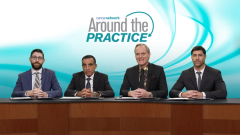
MAIA Trial: DRd in Patients with Newly Diagnosed MM
Insights gleaned from the MAIA trial, which researched daratumumab, lenalidomide, and dexamethasone in patients with newly diagnosed MM.
Episodes in this series

Transcript:
Ola Landgren, MD, PhD: The MAIA study was mentioned on both sides here, and it’s a really important study for the field. It shows that patients who stay on the combination of daratumumab, lenalidomide, and dexamethasone [DRd] have over 5 years of median progression-free survival [PFS]. That is quite amazing. If you think about how the trials were done years ago, using quite toxic chemotherapies, even with a transplant that’s also quite toxic, many of those trials had 4 or 5 years of median PFS. That means to me that patients who are older or frail vs younger and fit have access to very effective therapies. Is that your thinking also, Ben?
Benjamin Diamond, MD: Oh, absolutely. The data have matured wonderfully after the MAIA study. And as you said, Ola, the median PFS for patients in the DRd arm is basically 5 years, at 5 years of follow-up, vs about 3 years for the doublet. So there’s a clear winner here, and because there’s so little added toxicity, if anything, it’s sort of a no-brainer for us that we’d be using that combination for patients who can handle it.
Ola Landgren, MD, PhD: Dickran, there was an updated presentation recently in the Leukemia journal from the MAIA trial focusing on frail patients. This was led by Thierry Facon, [MD,] from the French myeloma group, focusing on frail patients. The results show a very similar outcome compared with the patients overall in the trial. In the standard of care clinical practice, how is frailty defined? Is that based on scores or just clinical assessments?
Dickran Kazandjian, MD: That’s a great question. I think frailty at its heart is a very subjective term. That’s why a number of groups have tried to make it a bit more objective. However, there are some nuances and intricacies in generating those scores. The reality is, for a seasoned clinician, their gestalt actually would overrule any scores that come up. At least in my clinic, you can kind of tell.
It’s also very important to realize that when patients with newly diagnosed myeloma first come into your clinic, they may have a very poor ECOG [performance status], and they may look very frail. But it’s important to separate frailty from their baseline situation to the frailty caused by the multiple myeloma itself. And I’m sure we’ve all had patients where after even 1 cycle of therapy, they almost start jogging, coming out of wheelchairs, and continue their marathon. I think it’s a judgment call. And as Ben said earlier, obviously the whole process is iterative, depending on how patients do with treatment moving forward, and we adjust things.
Transcript edited for clarity.
Newsletter
Stay up to date on recent advances in the multidisciplinary approach to cancer.























































































